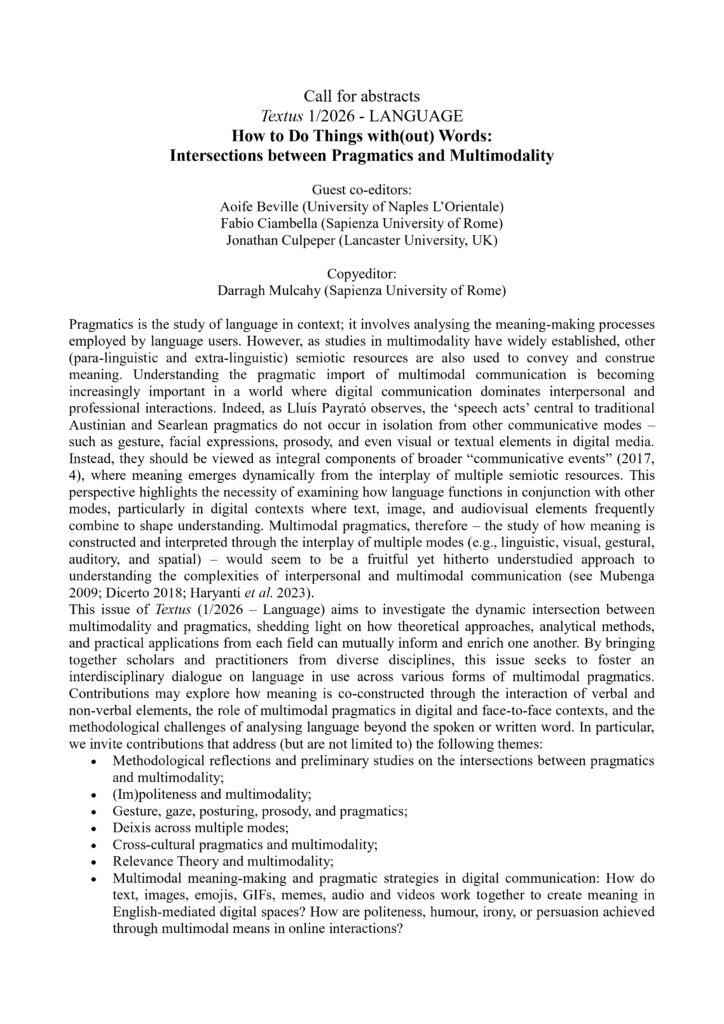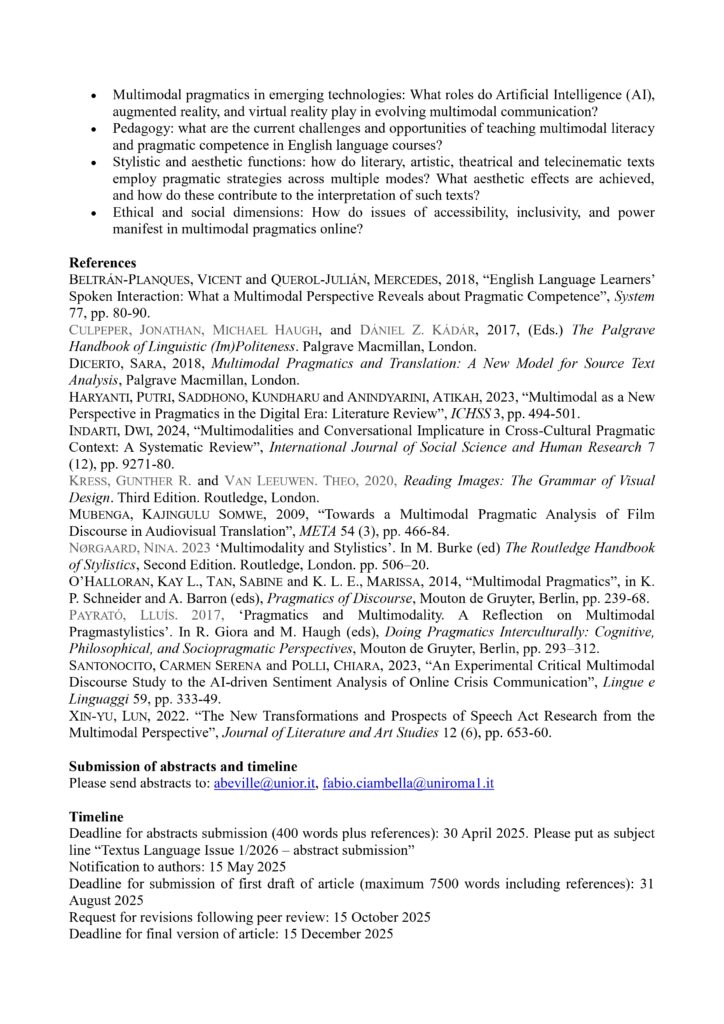How to Do Things with(out) Words: Intersections between Pragmatics and Multimodality
Guest co-editors:
Aoife Beville (University of Naples L’Orientale)
Fabio Ciambella (Sapienza University of Rome)
Jonathan Culpeper (Lancaster University, UK)
Copyeditor: Darragh Mulcahy (Sapienza University of Rome)
Pragmatics is the study of language in context; it involves analysing the meaning-making processes employed by language users. However, as studies in multimodality have widely established, other (para-linguistic and extra-linguistic) semiotic resources are also used to convey and construe meaning. Understanding the pragmatic import of multimodal communication is becoming increasingly important in a world where digital communication dominates interpersonal and professional interactions. Indeed, as Lluís Payrató observes, the ‘speech acts’ central to traditional Austinian and Searlean pragmatics do not occur in isolation from other communicative modes – such as gesture, facial expressions, prosody, and even visual or textual elements in digital media. Instead, they should be viewed as integral components of broader “communicative events” (2017, 4), where meaning emerges dynamically from the interplay of multiple semiotic resources. This perspective highlights the necessity of examining how language functions in conjunction with other modes, particularly in digital contexts where text, image, and audiovisual elements frequently combine to shape understanding. Multimodal pragmatics, therefore – the study of how meaning is constructed and interpreted through the interplay of multiple modes (e.g., linguistic, visual, gestural, auditory, and spatial) – would seem to be a fruitful yet hitherto understudied approach to understanding the complexities of interpersonal and multimodal communication (see Mubenga 2009; Dicerto 2018; Haryanti et al. 2023).
This issue of Textus (1/2026 – Language) aims to investigate the dynamic intersection between multimodality and pragmatics, shedding light on how theoretical approaches, analytical methods, and practical applications from each field can mutually inform and enrich one another. By bringing together scholars and practitioners from diverse disciplines, this issue seeks to foster an interdisciplinary dialogue on language in use across various forms of multimodal pragmatics. Contributions may explore how meaning is co-constructed through the interaction of verbal and non-verbal elements, the role of multimodal pragmatics in digital and face-to-face contexts, and the methodological challenges of analysing language beyond the spoken or written word. In particular, we invite contributions that address (but are not limited to) the following themes:
· Methodological reflections and preliminary studies on the intersections between pragmatics and multimodality;
· (Im)politeness and multimodality;
· Gesture, gaze, posturing, prosody, and pragmatics;
· Deixis across multiple modes;
· Cross-cultural pragmatics and multimodality;
· Relevance Theory and multimodality;
· Multimodal meaning-making and pragmatic strategies in digital communication: How do text, images, emojis, GIFs, memes, audio and videos work together to create meaning in English-mediated digital spaces? How are politeness, humour, irony, or persuasion achieved through multimodal means in online interactions?
· Multimodal pragmatics in emerging technologies: What roles do Artificial Intelligence (AI), augmented reality, and virtual reality play in evolving multimodal communication?
· Pedagogy: what are the current challenges and opportunities of teaching multimodal literacy and pragmatic competence in English language courses?
· Stylistic and aesthetic functions: how do literary, artistic, theatrical and telecinematic texts employ pragmatic strategies across multiple modes? What aesthetic effects are achieved, and how do these contribute to the interpretation of such texts?
· Ethical and social dimensions: How do issues of accessibility, inclusivity, and power manifest in multimodal pragmatics online?
References
BELTRÁN-PLANQUES, VICENT and QUEROL-JULIÁN, MERCEDES, 2018, “English Language Learners’ Spoken Interaction: What a Multimodal Perspective Reveals about Pragmatic Competence”, System 77, pp. 80-90.
CULPEPER, JONATHAN, MICHAEL HAUGH, and DÁNIEL Z. KÁDÁR, 2017, (Eds.) The Palgrave Handbook of Linguistic (Im)Politeness. Palgrave Macmillan, London.
DICERTO, SARA, 2018, Multimodal Pragmatics and Translation: A New Model for Source Text Analysis, Palgrave Macmillan, London.
HARYANTI, PUTRI, SADDHONO, KUNDHARU and ANINDYARINI, ATIKAH, 2023, “Multimodal as a New Perspective in Pragmatics in the Digital Era: Literature Review”, ICHSS 3, pp. 494-501.
INDARTI, DWI, 2024, “Multimodalities and Conversational Implicature in Cross-Cultural Pragmatic Context: A Systematic Review”, International Journal of Social Science and Human Research 7 (12), pp. 9271-80.
KRESS, GUNTHER R. and VAN LEEUWEN. THEO, 2020, Reading Images: The Grammar of Visual Design. Third Edition. Routledge, London.
MUBENGA, KAJINGULU SOMWE, 2009, “Towards a Multimodal Pragmatic Analysis of Film Discourse in Audiovisual Translation”, META 54 (3), pp. 466-84.
NØRGAARD, NINA. 2023 ‘Multimodality and Stylistics’. In M. Burke (ed) The Routledge Handbook of Stylistics, Second Edition. Routledge, London. pp. 506–20.
O’HALLORAN, KAY L., TAN, SABINE and K. L. E., MARISSA, 2014, “Multimodal Pragmatics”, in K. P. Schneider and A. Barron (eds), Pragmatics of Discourse, Mouton de Gruyter, Berlin, pp. 239-68.
PAYRATÓ, LLUÍS. 2017, ‘Pragmatics and Multimodality. A Reflection on Multimodal Pragmastylistics’. In R. Giora and M. Haugh (eds), Doing Pragmatics Interculturally: Cognitive, Philosophical, and Sociopragmatic Perspectives, Mouton de Gruyter, Berlin, pp. 293–312.
SANTONOCITO, CARMEN SERENA and POLLI, CHIARA, 2023, “An Experimental Critical Multimodal Discourse Study to the AI-driven Sentiment Analysis of Online Crisis Communication”, Lingue e Linguaggi 59, pp. 333-49.
XIN-YU, LUN, 2022. “The New Transformations and Prospects of Speech Act Research from the Multimodal Perspective”, Journal of Literature and Art Studies 12 (6), pp. 653-60.
Submission of abstracts and timeline Please send abstracts to: abeville@unior.it, fabio.ciambella@uniroma1.it
Timeline
Deadline for abstracts submission (400 words plus references): 30 April 2025. Please put as subject line “Textus Language Issue 1/2026 – abstract submission”
Notification to authors: 15 May 2025
Deadline for submission of first draft of article (maximum 7500 words including references): 31 August 2025
Request for revisions following peer review: 15 October 2025
Deadline for final version of article: 15 December 2025


